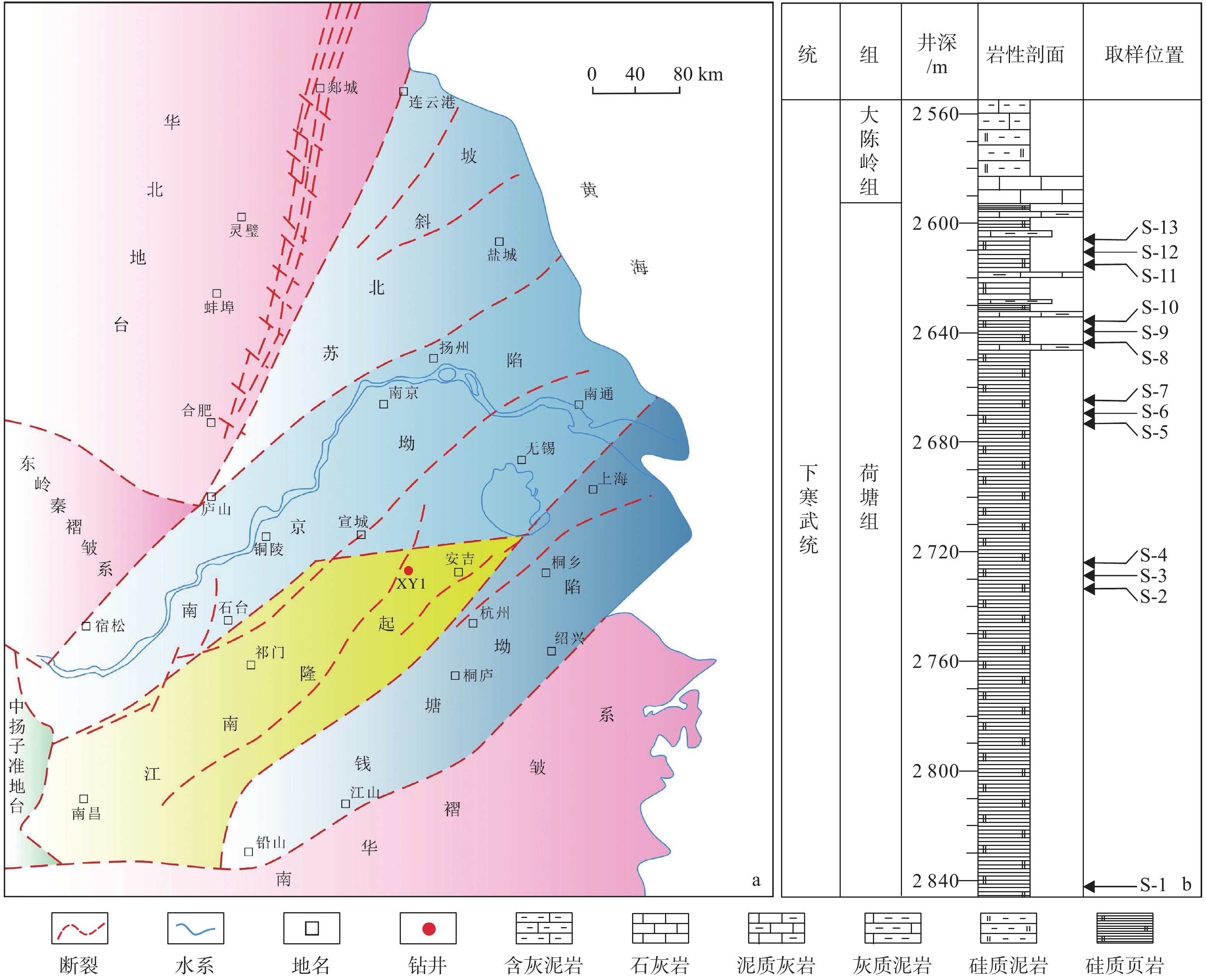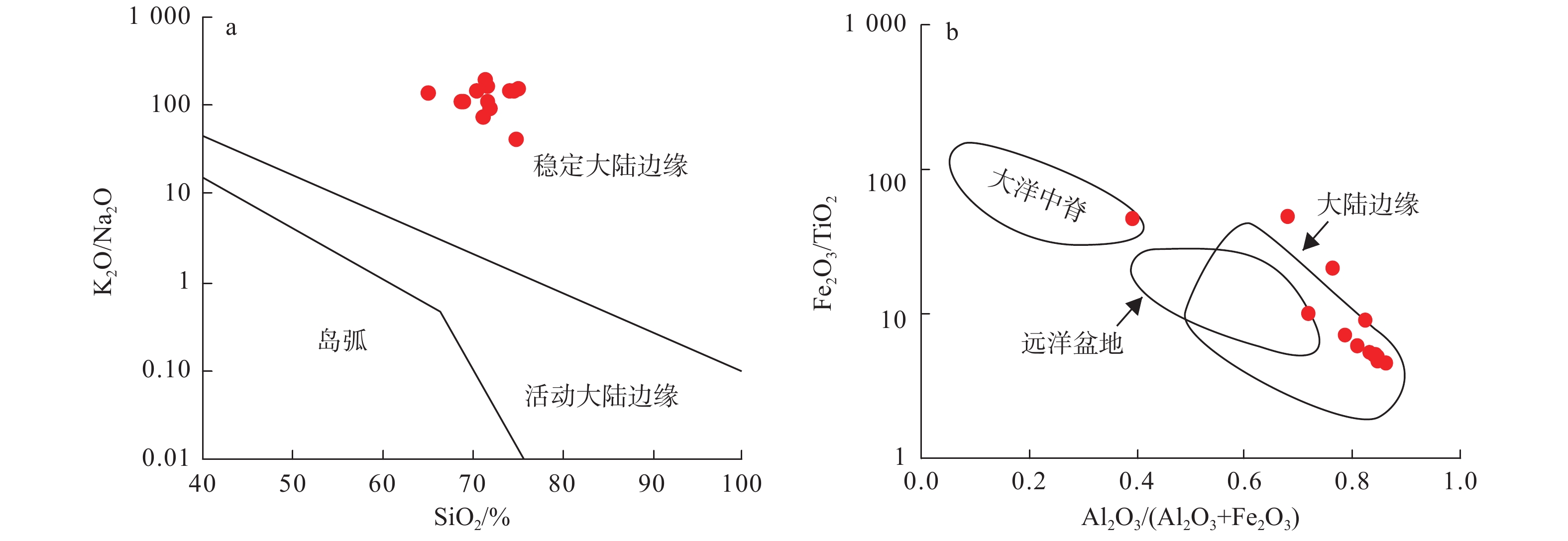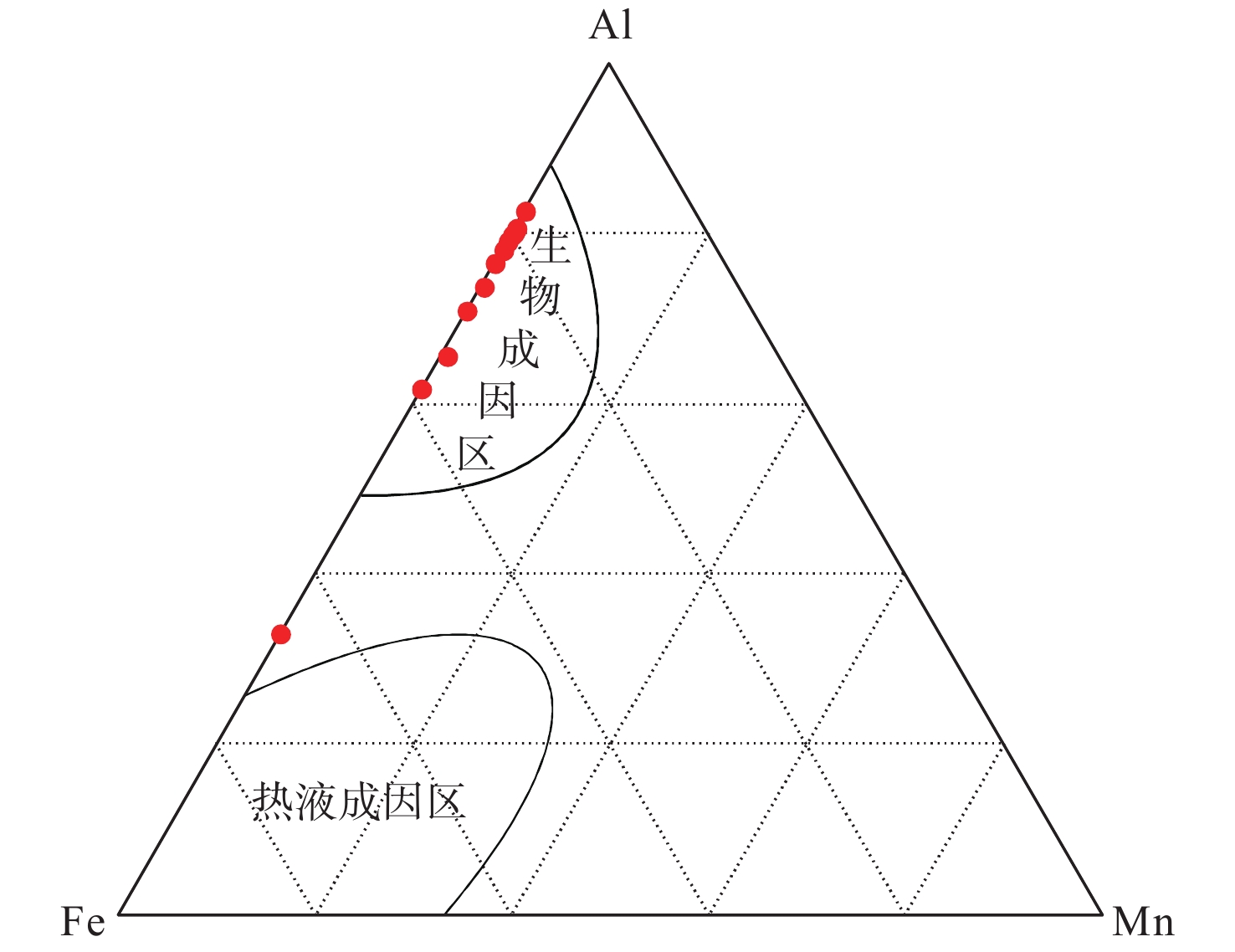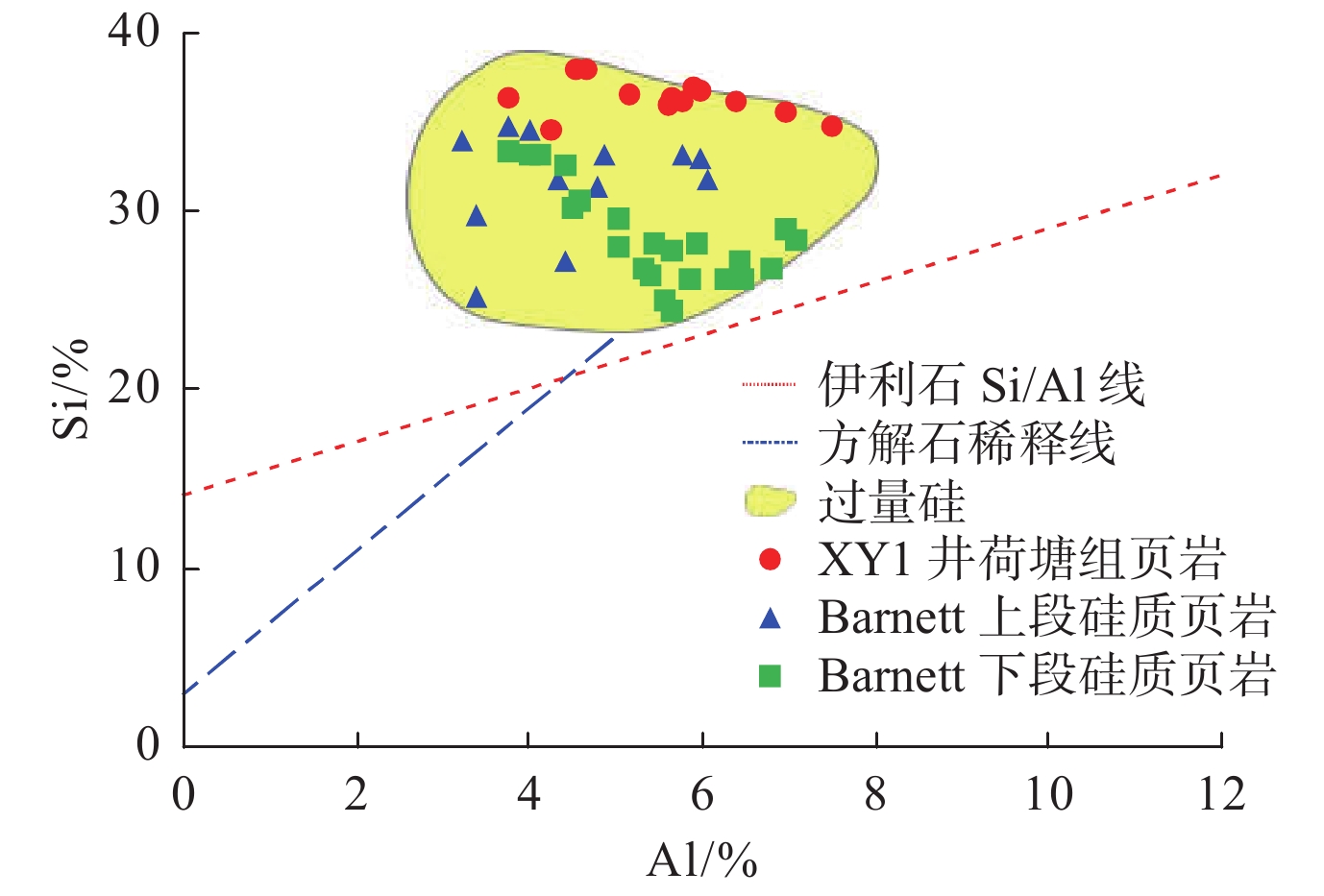Geochemical characteristics and significance of the shale of Lower Cambrian Hetang Formation in the southern Anhui Province of Lower Yangtze area
-
摘要:
中国南方下寒武统富有机质黑色页岩发育,具有分布面积广、沉积厚度大、有机碳含量高等有利条件,蕴藏着丰富的页岩气资源潜力,有望成为页岩气“增储上产”的重要区域。以下扬子地区下寒武统荷塘组页岩气首口参数井−XY1井为研究对象,利用岩芯资料和地球化学分析测试数据,探讨了研究区元素地球化学特征与古环境意义。研究结果表明:主量元素SiO2、K2O相对富集,其他元素均不同程度地相对亏损;微量元素Sr、Rb亏损,Ni、Co、Ba元素明显富集。荷塘组黑色页岩属大陆边缘沉积,硅质主要来源于硅质生物,为生物成因,沉积时期气候温暖潮湿,为咸水-高盐水体环境,有利于有机质的形成,沉积期具有较高的古生产力,水体环境以贫氧-厌氧为主,有利于有机质保存。
Abstract:The Lower Cambrian organic-rich black shale is well developed in southern China, which is wide in distribution, large in thickness and high in total organic carbon. It has great resource potential of shale gas and is expected to be an important succeeding field to meet the future increase in shale gas demand. This paper is devoted to the first parameter well XY1 of the Lower Cambrian Hetang Formation shale gas in the lower Yangtze area. Using cores and geochemical data, element geochemical characteristics and their paleoenvironmental significance are studied. The results show that the major elements SiO2 and K2O are relatively rich, and the others are lower to certain extent. As for trace elements, Sr and Rb are depleted, and the elements of Ni, Co and Ba are obviously enriched. The black shale of Hetang Formation is a kind of continental margin deposits. Silica mainly came from siliceous organisms under a warm and humid climate, and deposited in saline water, which is favorable to the deposition of organic matter. It is inferred that paleoproductivity of the Hetang Formation is high. The anaerobic water environment is conducive to the preservation of organic matter.
-

-
表 1 XY1井荷塘组样品常量元素分析结果表
Table 1. Results of major elements analysis of Hetang Formation shale of Well XY 1
% 样品号 SiO2 Al2O3 K2O Fe2O3 CaO MgO TiO2 P2O5 Na2O MnO 烧失量 Fe2O3/TiO2 过量硅 P/Ti S-13 71.84 8.98 5.33 4.22 0.80 0.53 0.09 0.05 0.05 0.00 7.69 46.89 43.91 1.39 S-12 71.18 9.81 5.57 2.07 1.67 1.02 0.23 0.07 0.08 0.01 7.92 9.00 40.67 0.76 S-11 69.04 6.29 3.19 2.44 4.96 2.59 0.24 0.06 0.03 0.04 11.44 10.17 49.48 0.63 S-10 65.07 7.05 4.06 10.88 0.29 0.53 0.24 0.07 0.03 0.00 12.15 45.33 43.14 0.73 S-9 71.46 10.07 5.63 2.33 1.43 0.92 0.38 0.07 0.03 0.01 7.36 6.13 40.14 0.46 S-8 70.45 9.71 5.51 2.60 2.27 0.85 0.36 0.06 0.04 0.02 7.78 7.22 40.25 0.42 S-7 75.30 8.21 4.39 1.48 2.25 0.99 0.31 0.06 0.03 0.01 6.84 4.77 49.77 0.48 S-6 74.71 10.54 5.52 1.90 0.76 0.80 0.37 0.06 0.04 0.01 4.99 5.14 41.93 0.41 S-5 74.33 10.68 5.57 1.98 0.76 0.76 0.37 0.07 0.04 0.01 5.06 5.35 41.12 0.47 S-4 71.78 12.42 6.49 1.96 0.41 0.84 0.43 0.07 0.04 0.00 5.17 4.56 33.15 0.41 S-3 68.76 13.08 6.33 2.47 0.24 1.00 0.47 0.08 0.06 0.00 7.17 5.26 28.08 0.43 S-2 75.01 7.94 4.45 2.46 2.21 0.42 0.12 0.06 0.11 0.00 6.87 20.50 50.32 1.25 S-1 71.98 11.26 5.49 2.24 0.62 0.88 0.41 0.08 0.06 0.01 6.57 5.46 36.96 0.49 平均值 71.61 9.70 5.19 3.00 1.44 0.93 0.31 0.07 0.05 0.01 7.46 9.68 41.46 0.64 上地壳(UCC) 66.60 15.40 2.80 5.04 3.59 2.48 0.64 0.15 3.27 0.10 注:上地壳(UCC)值引自文献[28]。 表 2 XY1井荷塘组样品微量元素分析结果表
Table 2. Results of trace elements analysis of Hetang Formation shale of Well XY 1
μg/g 样品号 Co Cr Cu Ni Rb Sr Th U V Ba 生物Ba Sr/Cu Rb/Sr S-13 32.20 49.70 80.70 85.90 95.61 25.30 8.90 7.87 197 11188 10822 0.31 3.78 S-12 21.30 47.70 36.80 47.70 100.92 42.50 8.80 8.30 147 6626 6227 1.15 2.38 S-11 31.30 32.20 18.10 33.20 57.98 130.00 5.68 6.89 78.4 1891 1635 7.19 0.45 S-10 51.30 29.90 260.00 229.00 68.24 14.50 6.57 11.00 99.9 2323 2036 0.06 4.70 S-9 21.00 49.70 46.30 40.70 101.07 30.90 9.52 7.59 79.2 2247 1836 0.67 3.27 S-8 19.70 45.90 73.50 65.50 95.97 38.90 9.66 6.66 92.9 2196 1800 0.53 2.47 S-7 29.70 43.20 23.50 43.30 81.33 33.30 7.90 7.37 193 1719 1384 1.42 2.44 S-6 21.50 59.60 32.70 76.90 110.34 24.20 9.53 8.06 360 1922 1492 0.74 4.56 S-5 25.90 57.00 31.80 79.30 108.42 24.60 9.18 7.11 291 1929 1494 0.77 4.40 S-4 22.20 70.40 31.50 70.50 128.42 24.10 11.30 7.50 290 2333 1826 0.77 5.32 S-3 19.70 84.90 32.20 109.00 124.69 22.50 11.80 14.60 719 3632 3099 0.70 5.54 S-2 39.30 46.90 86.10 78.80 69.16 69.50 6.87 8.21 222 8858 8534 0.81 0.99 S-1 20.30 72.00 44.40 93.20 105.40 30.40 10.20 11.00 451 3431 2972 0.68 3.47 平均值 27.34 53.01 61.35 81.00 95.97 39.28 8.92 8.63 248 3869 3474 1.22 3.37 上地壳(UCC) 4.2 18 7.4 140 320 10.4 2.4 97 620 注:上地壳(UCC)值引自文献[28]。 -
[1] 邹才能,董大忠,王社教,等. 中国页岩气形成机理、地质特征及资源潜力[J]. 石油勘探与开发,2010,37(6):641-653.
[2] 郭彤楼,张汉荣. 四川盆地焦石坝页岩气田形成与富集高产模式[J]. 石油勘探与开发,2014,41(1):28-36. doi: 10.11698/PED.2014.01.03
[3] 王志刚. 涪陵页岩气勘探开发重大突破与启示[J]. 石油与天然气地质,2015,36(1):1-6. doi: 10.11743/ogg20150101
[4] 郭旭升,胡东风,魏志红,等. 涪陵页岩气田的发现与勘探认识[J]. 中国石油勘探,2016,21(3):24-37. doi: 10.3969/j.issn.1672-7703.2016.03.003
[5] 梁兴,王高成,张介辉,等. 昭通国家级示范区页岩气一体化高效开发模式及实践启示[J]. 中国石油勘探,2017,22(1):29-37. doi: 10.3969/j.issn.1672-7703.2017.01.005
[6] 马永生,蔡勋育,赵培荣. 中国页岩气勘探开发理论认识与实践[J]. 石油勘探与开发,2018,45(4):705-713.
[7] 何希鹏,王运海,王彦祺,等. 渝东南盆缘转换带常压页岩气勘探实践[J]. 中国石油勘探,2020,25(1):126-136. doi: 10.3969/j.issn.1672-7703.2020.01.012
[8] 马新华,谢军,雍锐,等. 四川盆地南部龙马溪组页岩气储集层地质特征及高产控制因素[J]. 石油勘探与开发,2020,47(5):841-855.
[9] 赵文智,贾爱林,位云生,等. 中国页岩气勘探开发进展及发展展望[J]. 中国石油勘探,2020,25(1):31-44. doi: 10.3969/j.issn.1672-7703.2020.01.004
[10] 邹才能,赵群,丛连铸,等. 中国页岩气开发进展、潜力及前景[J]. 天然气工业,2021,41(1):1-14.
[11] 翟刚毅,包书景,王玉芳,等. 古隆起边缘成藏模式与湖北宜昌页岩气重大发现[J]. 地球学报,2017,38(4):441-447. doi: 10.3975/cagsb.2017.04.01
[12] 陈孝红,危凯,张保民,等. 湖北宜昌寒武系水井沱组页岩气藏主控地质因素和富集模式[J]. 中国地质,2018,45(2):207-226. doi: 10.12029/gc20180201
[13] 吴跃东. 皖南东至地区寒武纪沉积相及其时空演化[J]. 安徽地质,1997,7(3):34-39.
[14] CHEN Z, HU J, ZHOU C M, et al. Sponge assemblage from early Cambrian Hetang Formation, southern Anhui[J]. Chinese Science Bulletin, 2004, 49(15): 1625-1628.
[15] 路琳琳,纪友亮. 下扬子地区寒武纪层序格架及古地理演化[J]. 古地理学报,2013,15(6):765-776. doi: 10.7605/gdlxb.2013.06.063
[16] 刘占红. 下扬子地区下寒武统荷塘组泥页岩层序演化及其对气源潜力的控制:以杨树岭剖面为例[J]. 地质科技情报,2013,32(6):95-102,115.
[17] 卢炳雄,郑荣才,文华国,等. 皖南地区下寒武统页岩气成藏地质条件[J]. 石油与天然气地质,2014,35(5):712-719. doi: 10.11743/ogg20140517
[18] 张明扬,李贤庆,董泽亮,等. 皖南地区下寒武统荷塘组页岩矿物组成及脆度分析[J]. 矿物岩石地球化学通报,2015,34(1):177-183. doi: 10.3969/j.issn.1007-2802.2015.01.020
[19] 刘计勇,张飞燕,印燕铃. 下扬子下寒武统岩相古地理及烃源岩条件研究[J]. 海洋地质与第四纪地质,2018,38(3):85-95.
[20] 闫德宇,黄文辉,王婷灏,等. 中、下扬子地区下寒武统黑色页岩微量元素富集特征[J]. 地学前缘,2016,23(3):42-50.
[21] 张玉玺,陈建文,周江羽. 苏北地区早寒武世黑色页岩地球化学特征与有机质富集模式[J]. 石油与天然气地质,2020,41(4):838-851. doi: 10.11743/ogg20200416
[22] 任纪舜, 陈延愚, 牛宝贵, 等. 中国东部及邻区大陆岩石圈的构造演化与成矿[M]. 北京: 科学出版社, 1990: 5-16, 50-61.
[23] 陈沪生. 下扬子地区重建型海相烃源岩油气领域评价及勘探对策[J]. 海相石油地质,2002,7(2):33-41.
[24] 万天丰. 中国大地构造学纲要[M]. 北京: 地质出版社, 2004: 216-288.
[25] 郭念发. 下扬子盆地与区域地质构造演化特征及油气成藏分析[J]. 浙江地质,1996,12(2):19-27.
[26] 陈安定,刘东鹰,刘子满. 江苏下扬子区海相中、古生界烃源岩晚期生烃的论证与定量研究[J]. 海相油气地质,2001,6(4):27-34.
[27] 安徽省地质矿产局区域地质调查队. 安徽省地层志寒武系分层[M]. 安徽: 科学技术出版社, 1988: 5-9.
[28] TAYLOR S R, MCLENNAN S M. The continental crust: its composition and evolution[M]. Oxford: Blackwell Scientific Publications, 1985: 1-312.
[29] ROSER B P,KORSCH R J. Provenance signatures of sandstone-mudstone suites determined using discriminant function analysis of major-element data[J]. Chemical Geology,1988,67(1/2):119-139.
[30] MURRAY R W. Chemical criteria to identify the depositional environment of chert:general principles and applications[J]. Sedimentary Geology,1994,90:213-232. doi: 10.1016/0037-0738(94)90039-6
[31] BHATIA M R,CROOK K A W. Trace element characteristics of greywackes and tectonic setting discrimination of sedimentary basin[J]. Contribution to Mineralogy and Petrology,1986,92:181-193. doi: 10.1007/BF00375292
[32] BOSTROM K,KRAMEMER T,GANTNER S. Provenance and accumulation rates of opaline silica, Al, Fe, Ti, Mn, Ni, and Co in Pacific Pelagic sediment[J]. Chemical Geology,1973,11(1/2):123-148.
[33] ADACHI M,YAMAMOTO K,SΜGISAKI R. Hydrothermal chert and associated siliceous rocks from the northern Pacific their geological significance as indication of ocean ridge activity[J]. Sedimentary Geology,1986,47(1/2):125-148. doi: 10.1016/0037-0738(86)90075-8
[34] YAMAMOTO K. Geochemical characteristics and depositional environments of cherts and associated rocks in the Franciscan and Shimanto terranes[J]. Sedimentary Geology,1987,52(1/2):65-108.
[35] HOLDAWAY H K,CLAYTON C J. Preservation of shell microstructure in silicified brachiopods from the Upper Cretaceous Wilmington sands of Devon[J]. Geological Magazine,1982,119:371-382. doi: 10.1017/S0016756800026285
[36] LERMAN A. Lake: chemistry, geology, physics[M]. Berlin: Springer, 1978: 79-83.
[37] 陈骏,汪永进,陈旸,等. 中国黄土地层Rb和Sr地球化学特征及其古季风气候意义[J]. 地质学报,2001,75(2):259-266. doi: 10.3321/j.issn:0001-5717.2001.02.016
[38] 叶荷,张克信,季军良,等. 青海循化盆地23.1~5.0 Ma沉积地层中常量、微量元素组成特征及其古气候演变[J]. 地球科学:中国地质大学学报,2010,35(5):811-820.
[39] 张文防,戴霜,刘海娇,等. 六盘山地区下白垩统红色绿色泥岩地球化学特征及气候环境[J]. 地球科学进展,2012,27(11):1236-1244.
[40] TAYLOR S R,MCLENNAN S M. The geochemical evolution of the continental crust[J]. Reviews of Geophysics,1995,33(2):241-265. doi: 10.1029/95RG00262
[41] 杨振宇,沈渭洲,郑连弟. 广西来宾蓬莱滩二叠纪瓜德鲁普统—乐平统界线剖面元素和同位素地球化学研究及地质意义[J]. 地质学报,2009,83(1):1-15. doi: 10.3321/j.issn:0001-5717.2009.01.001
[42] ZHANG W W. Identification of sedimentary environment of fine-grained sedimentary rock based on major(trace)elements analysis:taking the lower fourth Member of Shahejie Formation in the well of Shen 352 of Anfutun area of Damintun Depression for example[J]. Journal of Northeast Petroleum University,2017,41(4):99-106.
[43] XIONG Z F,LI T G,ALGEO T,et al. Paleoproductivity and paleoredox conditions during late Pleistocene accumulation of laminated diatom mats in the tropical West Pacific[J]. Chemical Geology,2012,334:77-91. doi: 10.1016/j.chemgeo.2012.09.044
[44] DYMOND J,SUESS E,LYLE M. Barium in deep-sea sediment:a geochemical proxy for paleoproductivity[J]. Paleoceanography,1992,7(2):163-181. doi: 10.1029/92PA00181
[45] PI D H,LIU C Q,SHIELDS-ZHOU G A,et al. Trace and rare earth element geochemistry of black shale and kerogen in the early Cambrian Niutitang Formation in Guizhou province,South China:constraints for redox environments and origin of metal enrichments[J]. Precambrian Research,2013,225:218-229. doi: 10.1016/j.precamres.2011.07.004
[46] ALGEO T J,KUWAHARA K,SANO H,et al. Spatial variation in sediment fluxes,redox conditions,and productivity in the Permian-Triassic Panthalassic Ocean[J]. Palaeogeography,Palaeoclimatology,Palaeoecology,2011,308(1/2):65-83.
[47] 李艳芳,邵德勇,吕海刚,等. 四川盆地五峰组-龙马溪组海相页岩元素地球化学特征与有机质富集的关系[J]. 石油学报,2015,36(12):1470-1483. doi: 10.7623/syxb201512002
[48] ALGEO T J,INGALL E. Sedimentary Corg:P ratios,paleoceanventilation,and Phanerozoic atmospheric PO2[J]. Palaeogeography, Palaeoclimatology, Palaeoecology,2007,256(3/4):130-155.
[49] KIMURA H,WATANABE Y. Ocean anoxia at the Precambrian-Cambrian boundary[J]. Geology,2001,29(11):995-998. doi: 10.1130/0091-7613(2001)029<0995:OAATPC>2.0.CO;2
[50] TRIBOVILLARD N,ALGEO T J,LYONS T et al. Tracemetal as paleoredox and paleopro-ductivity proxies:an up-date[J]. Chemical Geology,2006,232(1):12-32.
[51] JONES B,MANNING D A. Comparison of geochemical indices used for the interpretation of palaeoredox conditions in ancient mudstones[J]. Chemical Geology,1994,111(1/4):111-129. doi: 10.1016/0009-2541(94)90085-X
-




 下载:
下载:





